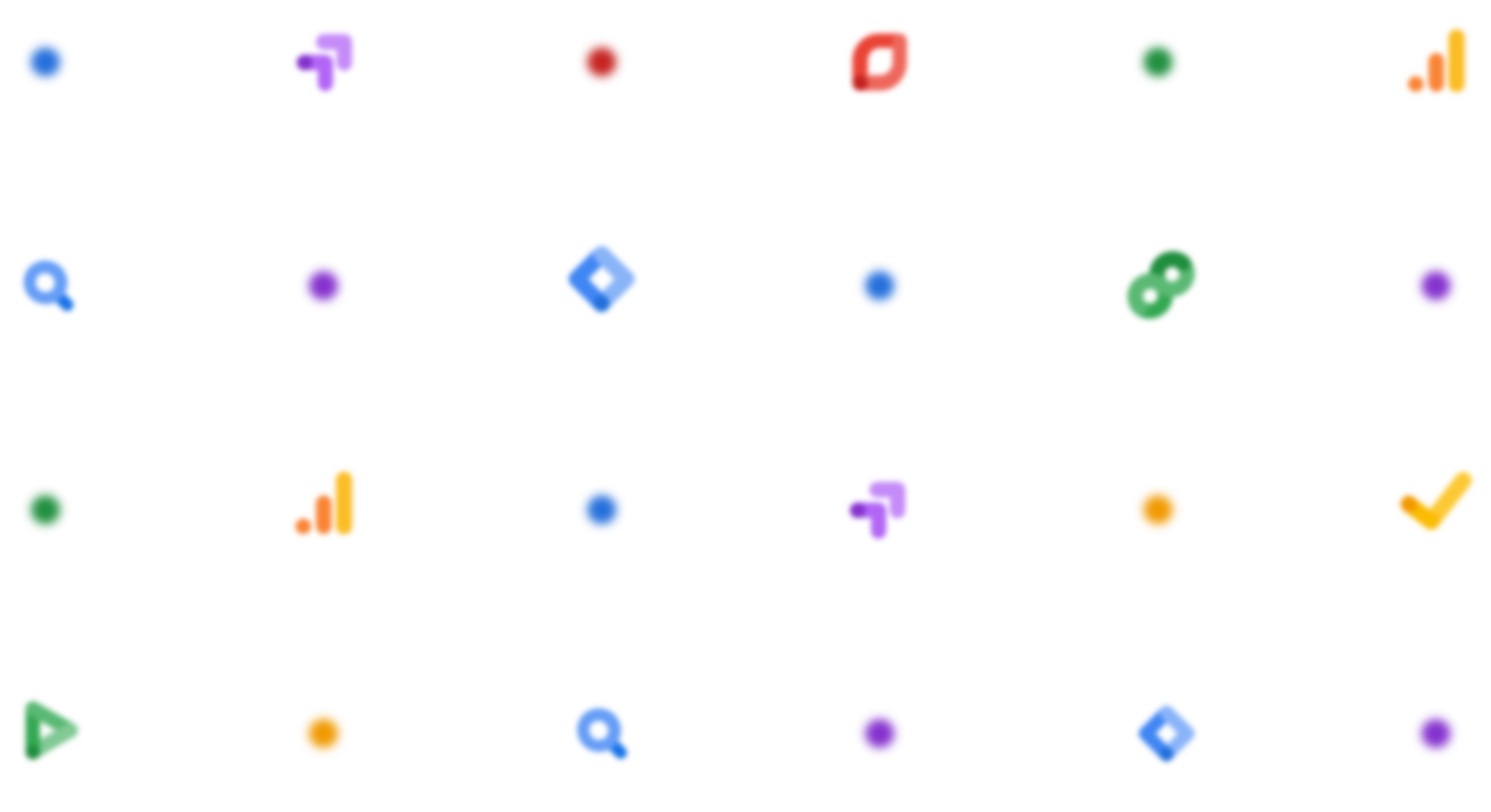
Google Marketing Platform
A Handcrafted Marketing Ecosystem
Design Brief
The primary objective of the Google Marketing Platform (GMP) initiative was to seamlessly unite Google's disparate ecosystem of marketing tools into a true platform solution.
The GMP initiative was launched to unify the product experience of over eight tools within Google’s marketing ecosystem, crafting them into a comprehensive platform experience that prioritized cross-product use cases.
Above: The GMP platform initiative (center logo) was launched to visually unite Google’s portfolio of marketing tools, aiming to drive cross-product growth and streamline the user experience.
My Role
During my time on the Google Marketing Platform (GMP) project, I held dual roles as Platform Design Lead and Staff Design Manager, overseeing both the strategic direction and management of the design team.
With a focus on unifying Google's marketing tools into a cohesive platform, I leveraged my expertise in design leadership to guide the team, foster collaboration, and drive the successful execution of this major iniativ.
Design Strategy
As the Design Lead for GMP, I developed a two-pillar product strategy to align with the initiative’s goals and to offer a unifying framework for the cross-functional team to get behind.
Seamless Integrations
Pillar 1
Objective
Create a seamless integration experience within GMP, enabling marketers to effortlessly connect their tools and workflows.
Approach
Employ intuitive cross-tool linking, unified navigation patterns, and consistent terminology to establish a cohesive and interconnected ecosystem. Streamline data transfer and synchronization between tools, minimizing manual effort and enhancing productivity. Implement customizable workflows and contextual information sharing to ensure a smooth and uninterrupted user journey.
Unified Navigation
Pillar 2
Objective
Streamline user navigation within GMP, enabling marketers to seamlessly move between tools and workflows.
Approach
Develop a unified navigation system that provides consistent access to different product areas. Implement intuitive information architecture and menu structures that reflect user mental models and enable efficient task completion. Simplify tool-switching by integrating common functionalities and providing contextual links. Focus on clear labeling, visual cues, and efficient search capabilities to enhance discoverability and reduce friction in navigating GMP.

Brand Design
The branding effort within the Google Marketing Platform (GMP) project was the first step in establishing a cohesive platform experience and signaling to users that these tools were not becoming interoperable.
Prior to the unification efforts, there was significant market confusion surrounding Google's array of tools, resulting in fragmented user experiences and a lack of cohesive messaging. The branding design initiative within GMP aimed to address this challenge.
Before
Before the GMP initiative, branding was divergent, with each product team focused on their specific tool, resulting in limited cross-product consistency.
After
Consistent color, shape, and line-weight created a unified brand language, solidifying the GMP initiative as a platform of marketing tools.
Design System
At the heart of the GMP project, my team and I recognized the need for a cohesive design system that was scalable to tackle the design challenges across the diverse range of products within the GMP platform.
This design system became a powerful tool in solving both broad and detailed design problems. We focused on a molecular design approach that addressed layout, interaction and styling.
Platform Menu
The GMP menu was added into the header of each product in the platform. This afforded users to switch between the various platform tools without having to open a new browser window. It also allowed for a marque presentation of the GMP logo and affordance to learn about marketing tools that the user hasn’t discovered yet.
Details Page
Prior to the GMP initiative, every product had its own details page design. The GMP design system outlined and canonized how details pages should be presented in terms of layout, typography and interaction.
Products that utilized this pattern:
Google Analytics
Google Tag Manager
Google Optimize
Google Attribution
Google Data Studio
Inspector Panel
Some products within the Google Marketing Platform needed a consistent inspector panel for both edit and view purposes. The GMP design system addressed all the nuanced variations of this standard panel, including button layout, margins, settings arrangement and actions.
Products that utilized this pattern:
Google Data Studio
Google Sebelius
Picker Slider
This slide-over panel was created to address an essential use-case where a list of entities are presented to choose from while also offering an affordance to create a new entity or even edit an existing entity before choosing.
Products that utilized this pattern:
Google Analytics
Google Tag Manager
Google Optimize
Google Data Studio
Half Slider
Similar to the Picker Slider, this half-sized version focused on “type” picking instead of “entity” picking. Without the need to present attributes in a table, a list view layout gave way to its compact size that also allowed for differentiation from the larger picker.
Information Architecture
In the process of redesigning the information architecture, our focus was on creating an intuitive and easily accessible top-level presentation that prioritized the core entities.
Throughout the Google Marketing Platform (GMP), we identified the most common entities to be Accounts, Containers, Users, and the corresponding privileges associated with each of these entities. With this understanding, my team of designers diligently worked to surface these core entities, along with the secondary entities, in a comprehensive and user-centric approach.
The introduction of the new navigation system enabled users to effortlessly navigate to any entity throughout the platform with just a few clicks or taps. Existing users appreciated the expedited workflows, while UX research revealed that new users experienced less difficulty in adopting new products and acclimating to the platform.
Impact & Success
The Google Marketing Platform (GMP) has significantly transformed the digital marketing landscape, empowering businesses to plan, execute, and measure their marketing strategies with exceptional efficiency and effectiveness.
After launch, GMP met and exceeded several key metrics, surpassing expectations.
Increased Conversion Rates: Marketers using GMP reported up to 30% increase in conversion rates through leveraging multiple platform products.
Actionable Insights: GMP's advanced analytics capabilities helped marketers uncover valuable insights and trends, resulting in up to a CSAT improvement of over 33%.
Enhanced Reporting: Businesses leveraging GMP have benefited from up to a 40% reduction in time spent on reporting, thanks to customizable dashboards and streamlined reporting features.
Growing User Base: GMP has experienced a steady increase in its user base, with over 50,000 businesses adopting the platform to date.
Positive User Feedback: GMP has received an average user satisfaction rating of 4.5 out of 5, indicating high user engagement and positive feedback on its capabilities.
Key Learnings
As the Design Lead for the GMP project, I had the privilege of being at the forefront of this transformative initiative. Throughout this journey, I gained invaluable insights and experiences that have shaped my understanding of design and collaboration.
These key learnings not only shaped my design approach but also provided valuable insights into navigating large-scale projects and effectively communicating the vision to stakeholders.
Design For A Cohesive Market Story: Through my GMP experience, I learned that a deep understanding of market positioning and perception offers invaluable design insights. Value propositions being expressed into the market need to show up in the end user’s experience or else there’s a disconnect with anticipated value and delivered value.
Embrace Iterative Roadmaps: The GMP project taught me the value of an iterative roadmap in successfully executing a large-scale initiative. By breaking down the project into manageable phases, we avoided becoming overwhelmed and fostered collaboration across cross-product teams. The iterative approach allowed us to gather feedback, make refinements, and adapt our plans as needed. It provided us with the flexibility to navigate complexities and maintain a steady pace toward our goals.







